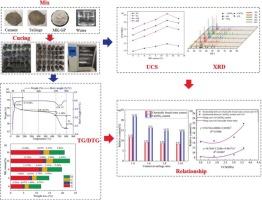龄期、水泥/尾砂比、MK-GP掺量对胶凝膏体充填体力学特征及演化机制的影响
IF 4.6
2区 工程技术
Q2 ENGINEERING, CHEMICAL
引用次数: 0
摘要
由于水泥相关成本很高(约占总填充成本的70%),因此水泥浆填料(CPF)的成本是限制其进一步推广的主要因素。相反,偏高岭土聚合物(MK-GP)可以部分切换水泥,并具有优越的稳定性和强度。本文以全铁尾矿为研究对象,加入MK-GP替代部分水泥,制备了一种新型充填体。主要关注龄期、水泥/尾矿(c/t)率、MK-GP用量等特征。本研究通过单轴抗压强度(UCS)、热重分析(TGA)和x射线衍射(XRD)测试,探索CPF的强度演化规律,阐明其微观特征,解释其强度响应机制。结果表明,随着MK-GP用量的增加,CPF的强度先上升后下降。当MK-GP含量达到12%时,充填体强度达到峰值。x射线衍射(XRD)和热重差热分析(TG-DTA)结果表明,随着MK-GP的加入,氢氧化钙(CH)先升高后降低。充填体强度与CH含量呈二次函数关系。当MK-GP含量为12%时,CH的含量达到最大值。然而,当MK-GP的加入量增加到16%时,这一趋势发生逆转,可能是由于过量的MK-GP增加了颗粒间的连接,阻碍了进一步的水化,导致水化产物下降,最终导致充填体强度下降。最后,本研究为制造新的充填体产品提供了新的愿景,并为其他类似采矿作业中充填体混合比的工程意图提供了可靠的参考。本文章由计算机程序翻译,如有差异,请以英文原文为准。

Effect of age, cement/tailings rate, and MK-GP dosage on mechanical features and evolution mechanism of cementitious paste fill
As the cost of cemented paste fill (CPF) is a major factor limiting its further dissemination since cement-related costs are high (∼70 % of total fill costs). In contrast, metakaolin-based geopolymer (MK-GP) can partly switch cement and states superior stability/strength. This paper takes full iron mine tailings as the research object, incorporating MK-GP to substitute for part of cement and preparing a new fill type. It mostly focuses on features like age, cement/tailings (c/t) rate, and MK-GP dosage. Using uniaxial compressive strength (UCS), thermo-gravimetric analysis (TGA) and X-ray diffraction (XRD) tests, this research aims at exploring the strength evolution pattern of CPF, clarify its microscopic features, and interpret its strength response mechanism. Results specify that the strength of CPF firstly rises and later falls by growing MK-GP dosage. When MK-GP content reaches 12 %, fill's strength reaches its peak. Besides, X-ray diffraction (XRD) and thermo-gravimetric-differential thermal analysis (TG-DTA) results show that calcium hydroxide (CH) initially increases and then decreases with adding MK-GP. Backfill strength exhibits a quadratic function link with the CH content. For a MK-GP content of 12 %, the amount of CH reaches its maximum. However, when the addition number of MK-GP increases to 16 %, the trend reverses, possibly due to an excessive amount of MK-GP increasing inter-particle connections, hindering further hydration, leading to a fall in hydration products and finally causing a drop in fill strength. Lastly, this study offers new visions intended for manufacturing new fill products and afford confident references for the engineering intention of fill mix ratios at other similar mining operations.
求助全文
通过发布文献求助,成功后即可免费获取论文全文。
去求助
来源期刊

Powder Technology
工程技术-工程:化工
CiteScore
9.90
自引率
15.40%
发文量
1047
审稿时长
46 days
期刊介绍:
Powder Technology is an International Journal on the Science and Technology of Wet and Dry Particulate Systems. Powder Technology publishes papers on all aspects of the formation of particles and their characterisation and on the study of systems containing particulate solids. No limitation is imposed on the size of the particles, which may range from nanometre scale, as in pigments or aerosols, to that of mined or quarried materials. The following list of topics is not intended to be comprehensive, but rather to indicate typical subjects which fall within the scope of the journal's interests:
Formation and synthesis of particles by precipitation and other methods.
Modification of particles by agglomeration, coating, comminution and attrition.
Characterisation of the size, shape, surface area, pore structure and strength of particles and agglomerates (including the origins and effects of inter particle forces).
Packing, failure, flow and permeability of assemblies of particles.
Particle-particle interactions and suspension rheology.
Handling and processing operations such as slurry flow, fluidization, pneumatic conveying.
Interactions between particles and their environment, including delivery of particulate products to the body.
Applications of particle technology in production of pharmaceuticals, chemicals, foods, pigments, structural, and functional materials and in environmental and energy related matters.
For materials-oriented contributions we are looking for articles revealing the effect of particle/powder characteristics (size, morphology and composition, in that order) on material performance or functionality and, ideally, comparison to any industrial standard.
 求助内容:
求助内容: 应助结果提醒方式:
应助结果提醒方式:


